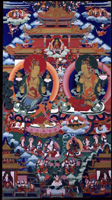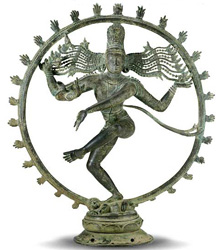
| Erica B. Svatek |
| Home |
| Geography |
| Religion |
| Literature
& Art |
| Modern Conflicts |
| Connections |
| Resources |
| About the Author |
| Bibliography |

The art of the Himalayan region is some of the best in the world. Artistic trends, practices, and forms are deeply rooted in the religious consciousness of the community. A discussion of the Himalayas would be incomplete and drastically lacking without an in-depth discussion of the artwork. Art and Himalayan life is inextricably linked; utilization of art in the classroom can foster discussions about geography, religion, social hierarchy, and much more. The pieces below and the lessons at the bottom of the page serve to represent the variety of Buddhist and Hindu art in the Himalayas, as well as a foundation for an accurate discussion of Himalayan art within your non-art classroom.
Central Questions for discussing art:
- How was the piece made?
- What is the function of the piece? How would it have been
used both practically and socially?
- How is color utilized in the piece?
- What is the role of space within the piece (used and unused space)?
- What shapes are used in the piece?
- What is its history and location? What is its story?
- Is there anything missing from this piece?
Some artwork to inspire you!
 Thangka
of Maitreya:
Thangka
of Maitreya: A thangkas is a painted or embroidered Buddhist banner that is usually hung in a home or in a monastery. A well created thangkas serves many purposes from teachings of the Buddha, to sacred images, historical events, devotional images, mythology, and images of the Lamas. This practice is very similar to the way stained glass windows in Christian cathedrals and churches portray sacred images and lessons of Christ.
This particular thangkas uses vivid color, positive and negative space, and architecture to depict the steps to enlightenment. Buddhist art has a specific hierarchy for importance. The largest images are the focal points and therefore the most important part of the art. They are usually in the center of the work. This thangkas has the images for wisdom and compassion at its center telling the viewer that this work is about the enlightenment of Buddha. Above them is am image of Buddha himself situated in a pagoda-like temple. At the top of any Buddhist artwork one can usually fine images of part Buddhas. At the bottom of any Buddhist artwork one can usually find demons or images of the patron who commissioned the work. The style of this piece and use of architectural features tells the view a great deal about origins of the piece. The pagoda-like temple indicates that this thangka is a Chinese influenced work and most likely from Eastern Tibet. The colors and empty space also indicate an eastern influence. More information about this specific work can be found at www.himalayanart.org
Mandala of Manjushri:

Mandalas are an integral part of Buddhist
practice that are
rarely seen by the uninitiated. They are
intensely symbolic, colorful, spiritual, and full of repeated shapes. A mandala is a two-dimensional representation
of a three-dimensional idea. Imagine
that the center of the mandala is the top if a building; that you
pulling the
mandala towards you from the center image.
Mandalas are all about repeating shapes;
squares and
circles. Circles are a perfect shape,
never-ending and occur in nature. Squares
are often man-made, have corners, and are thought
of as
rigid. Each section of the mandala
represents a teaching of Buddhist philosophy and represents a stage in
your
path to enlightenment. A view must start
at the edge of the mandala and work towards the center, passing each
test, each
stage, in order to proceed to the next. This
art form is a devotional work that monks will
meditate over for
long durations of time, working from the outside to the inside of the
piece. Sometimes these works tell stories
of the
Buddha, past Buddha’s, struggles that must be over come, myths, tales,
or
specific Buddhist teachings.
The use of color in Mandalas is very
specific. Each square is divided into
different
sections, each with its own color, meaning and doorway.
In addition, the use of positive and negative
space has meaning and a specific pattern.
As with all Himalayan artwork there is a hierarchy of importance within the piece. The largest objects are the focal point and are usually centered in the work. At the top, are protective deities and past Buddha’s, and at the bottom are demons, patrons, or other obstacles to overcome. Mandalas are rich sources for learning about the Buddhist religion, the role of geography, the role of specific people, and much more. For more information about this Mandala visit www.himalayanart.org.
 This
spectacular bronze work is an image of the Hindu god
Shiva dancing in a ring of fire. Shiva
is has multiple arms and in each hand contains a different image
representing a
various aspect of the Hindu faith (drums, lightening bolts, lotus,
etc.). Each hand is also in a different
mudra, or
gesture, again each represents a different teaching or lesson. Careful attention must be given to the
jewelry Shiva is wearing and what cultural aspects might be drawn based
on the
types of jewelry shown. In addition, he
is stepping on, literally crushing, someone beneath his feet – he is
stepping
on ignorance. The stories behind
Himalayan art such as this work are rich in literary tradition and
occasionally
controversy.
This
spectacular bronze work is an image of the Hindu god
Shiva dancing in a ring of fire. Shiva
is has multiple arms and in each hand contains a different image
representing a
various aspect of the Hindu faith (drums, lightening bolts, lotus,
etc.). Each hand is also in a different
mudra, or
gesture, again each represents a different teaching or lesson. Careful attention must be given to the
jewelry Shiva is wearing and what cultural aspects might be drawn based
on the
types of jewelry shown. In addition, he
is stepping on, literally crushing, someone beneath his feet – he is
stepping
on ignorance. The stories behind
Himalayan art such as this work are rich in literary tradition and
occasionally
controversy.
The image is intense and demands the
viewer’s full
attention. The intensity is also
representative of the importance this work plays, and the story behind
it,
within the Hindu faith. Shapes are again
important. A triangle is formed by
connecting the three prominent arms of Shiva (two outstretched and one
below). Shiva himself is enclosed in a
ring of
fire. The circle again represents a
perfect or ideal shape, and a never-ending shape. It
may be of interest to you and your
students to talk about the process that artisans underwent to make such
a
masterpiece. The lost-wax process is an
interesting and complicated process that is still used today by some
artists. For more information about this
specific piece visit the Art Institute
of Chicago.
| Buddhist Art Lesson |
Hindu Art Lesson |